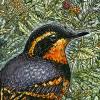

Join BirdNote tomorrow, November 30th!
Illustrator David Sibley and actor H. Jon Benjamin will face off in the bird illustration battle of the century during BirdNote's Year-end Celebration and Auction!
Some swifts and frigatebirds stay aloft for months. But for a long time, scientists did not know if the birds might be sleeping on the wing. A 2016 study provided answers. Tiny devices attached to the heads of frigatebirds revealed fascinating information: the birds did sleep while aloft, most often one half of the brain at a time. But they also fell into normal, whole-brain sleep and sometimes, even deeper REM sleep. But this deepest sleep came in bursts of just a few seconds — an inflight power-nap.
BirdNote®
New Research Shows How Birds Sleep in Flight
Written by Bob Sundstrom
This is BirdNote.
Some swifts and frigatebirds stay aloft for months at a time. Scientists know this because they attached sensors to the birds. What they hadn’t been able to learn for certain was whether birds might be sleeping on the wing, and if they do, for how long. It was thought that one half of a bird’s brain might sleep at a time, as happens with some birds when resting on the ground.
A 2016 study provided some solid answers. Tiny devices attached to the heads of frigatebirds tracked electroencephalograph patterns and — crucially — head movements.
[Magnificent Frigatebird, http://macaulaylibrary.org/audio/136235, 0.13-18]
The results were fascinating: Frigatebirds did sleep while aloft, most often one half of the brain at a time, as suspected. But, they also fell into normal, whole-brain sleep, and sometimes, even deeper REM sleep. But this deepest sleep came in bursts of just a few seconds, during which time the bird’s head dipped but its flight pattern stayed steady — an inflight power-nap.
So frigatebirds do sleep on the wing. Just not very much: on average, 42 minutes per day. When perched on land, they sleep 12 hours a day. What still has scientists puzzled is how they can get by with so little sleep when flying for months at a time.
For BirdNote, I’m Mary McCann.
###
Bird sounds provided by The Macaulay Library of Natural Sounds at the Cornell Lab of Ornithology, Ithaca, New York. 136235 recorded by Martha J Fischer.
BirdNote’s theme music was composed and played by Nancy Rumbel and John Kessler.
Producer: John Kessler
Executive Producer: Sallie Bodie
© 2017 Tune In to Nature.org January 2017/2019/2021 July 2023
Narrator: Mary McCann
ID# flight-11-2021-1-31 flight-11
http://gizmodo.com/we-finally-know-how-birds-sleep-during-flight-withou… research article on frigatebirds and sleep in flight








